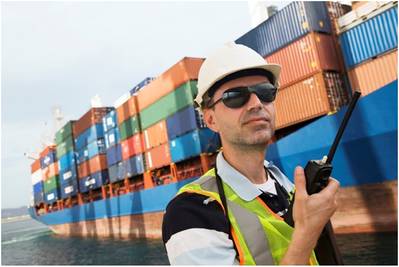Every port and terminal facility needs weighing systems for containers. Weighing is critical in several processes in ports where accurate readings are paramount. To achieve this, the following weighing solutions can be incorporated.
1. Weighbridges
Weighbridges offer a vehicle weighing solution that may be placed at entrances and exits of the ports and terminals. An incoming truck can drive over the weighbridge and the total weight will be registered immediately. The tare weight of the truck must be deducted from the total weight to determine the container weight. The truck’s tare weight can be measured if the truck leaves the terminal empty or the weight of the truck can be declared when entering the terminal.
Weighbridges can be pit-mounted or surface mounted.
Weighbridges can boast extremely high accuracy, very often up to +/- 20kg, however, in order to achieve this, the truck needs to come to a standstill on the bridge. Ensure that an accredited technician recalibrates the weighbridges periodically to ensure accurate weighing. Weighbridges can be paired with a driver operated console to enable fuller automation of the weighing process.
2. Load Cells
Load cells can be installed on:
- •STS cranes: Load cells on ship-to-shore (STS) cranes are generally installed at the rope ends of the crane trolleys or booms or sheave pins. They usually act as an overload protection system rather than a weighing system. With a weighing inaccuracy of about 3-5 percent of the maximum STS crane lift weight, load cells on STS need to be periodically recalibrated. All the latest models of new STS cranes have an overload protection system installed as standard.
- •RTGs: Load cells can be implemented on rubber-tyredgantry cranes (RTGs). Here, the installation is done in the shafts of the rope sheaves on the trolley or in the rope anchors. Installation on existing cranes can be tricky if no drawings of the sheaves and shafts are available. If the cranes are equipped with twin-lift spreaders, the load cells won’t be able to measure each container individually.
- •Straddle Carriers: You can also install load cells on straddle carriers hoist systems, though the degree of inaccuracy is quite large. These systems cannot weigh containers individually if the straddle carrier is fitted with a twin-lift spreader sand they cannot determine container loading eccentricities. If one container is loaded and one is empty or is light weighted, accidents will be more common.
3. Weighing Systems on MHCs
An MHC, otherwise known as a mobile harbor crane, requires a weighing system to control the stability of the crane, as the load weight is strictly limited depending on the boom outreach.
Crane manufacturers usually integrate these systems during the production process. The MHC weighing systems often measure the hydraulic pressure in the boom lift cylinders or it may be built into the rope system.
4. Weighing Systems on Reach Stackers
Most reach stackers have built-in systems that use hydraulic oil pressure in the boom lift cylinders to measure load weight. These aren’t very accurate, and their performance may vary based on whether the reading is taken after a hoist movement or after the lowering of a load. Users may see quite a large difference in reading, which is caused by the friction in the cylinders.
5. Weighing Systems on Container Handling FLTs
Weighing systems used for container handling fork lift trucks (FLTs) generally work by measuring the hydraulic oil pressures in the lift cylinders. Load cells may also be installed under the chain anchors. Friction in the hydraulic cylinders may cause some inaccuracies in the system.
Where Should the Weighing System be Installed?
There is no rule of thumb on where a weighing system must be installed in the terminal. That decision can be made based on the logistics flow of the facility. Other factors that help in determining the installation location of a weighing system include the size of the terminal and the type of container handling equipment that is in use. If a container is weighed only when it is being loaded onto a vessel, then it is too late in the process. Incorporate weighing early on in the process for greater accuracies.
The Author














